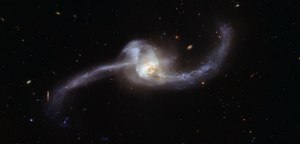NGC 2623
| Galaxy NGC 2623 |
|
|---|---|

|
|
| The double galaxy NGC 2623 imaged by the Hubble Space Telescope | |
| AladinLite | |
| Constellation | cancer |
|
Position equinox : J2000.0 , epoch : J2000.0 |
|
| Right ascension | 08 h 38 m 24.1 s |
| declination | + 25 ° 45 ′ 17 ″ |
| Appearance | |
| Morphological type | Pec; LINER; LIRG Sy2 |
| Brightness (visual) | 13.2 mag |
| Brightness (B-band) | 14.0 mag |
| Angular expansion | 2.4 ′ × 0.7 ′ |
| Position angle | 60 ° |
| Surface brightness | 13.6 mag / arcmin² |
| Physical data | |
| Redshift | 0.018509 ± 0.000003 |
| Radial velocity | (5549 ± 1) km / s |
|
Stroke distance v rad / H 0 |
(245 ± 17) · 10 6 ly (75.1 ± 5.3) Mpc |
| diameter | 50,000 ly |
| history | |
| discovery | É. J.-M. Stephan |
| Discovery date | January 19, 1885 |
| Catalog names | |
| NGC 2623 • UGC 4509 • PGC 24288 • CGCG 120-015 • MCG + 04-21-009 • IRAS 08354 + 2555 • 2MASX J08382409 + 2545167 • Arp 243 • VV 79 • | |
NGC 2623 = Arp 243 is a merging double galaxy in the constellation Cancer , which is about 245 million light years from the Milky Way . Halton Arp organized his catalog of unusual galaxies into groups according to purely morphological criteria. This galaxy belongs to the class galaxies showing signs of splitting .
The galaxy NGC 2623 was discovered on January 19, 1885 by the French astronomer Édouard Jean-Marie Stephan .
Web links
Commons : NGC 2623 - collection of images, videos, and audio files
literature
- Jeff Kanipe and Dennis Webb: The Arp Atlas of Peculiar Galaxies - A Chronicle and Observer's Guide , Richmond 2006, ISBN 978-0-943396-76-7
